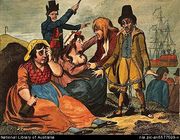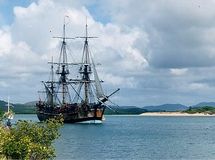Botany Bay

Botany Bay is a bay in Sydney, New South Wales, a few kilometres south of the Sydney central business district. The Cooks River and the Georges River are the two major tributaries that flow into the bay. Two runways of Sydney Airport extend into the bay.
On 29 April 1770, Botany Bay was the site of James Cook's first landing of HMS Endeavour on the continent of Australia, after his extensive navigation of New Zealand. Later the British planned Botany Bay as the site for a penal colony. Out of these plans came the first European habitation of Australia at Sydney Cove.
Contents |
History

Aboriginal
Archaeological evidence from the shores of Botany Bay has yielded evidence of Aboriginal settlement dating back 5,000 years. The Aboriginal people of Sydney were known as the Eora with sub-groups derived from the languages they spoke. The people living between the Cooks River and the Georges River were the Bidgigal. On the southern shores of the bay were the Gweagal.[1] On the northern shore it was the Kameygal.[2]
European
James Cook's landing
James Cook's landing marked the beginning of Britain's interest in Australia and in the eventual colonisation of this new Southern continent.[3] Initially the name Sting Ray Harbour was used by Cook and other journal keepers on his expedition, for the stingrays they caught. That name was recorded on an Admiralty chart too.[4] Cook's log for 6 May 1770 records "The great quantity of these sort of fish found in this place occasioned my giving it the name of Stingrays Harbour". However, in his journal (prepared later from his log), he changed to "The great quantity of plants Mr. Banks and Dr. Solander found in this place occasioned my giving it the name of Botany Bay".[5] Initially the name Botanist Bay was also sometimes used.
First Fleet arrives
Governor Arthur Phillip sailed the Armed Tender "Supply" into the bay on 18 January 1788. Two days later the remaining ships of the First Fleet had arrived to found the planned penal colony. Finding that the sandy infertile soil of the site in fact rendered it most unsuitable for settlement, Phillip decided instead to move to the excellent natural harbour of Port Jackson to the north. On the morning of 24 January the French exploratory expedition of Jean-François de La Pérouse was seen outside Botany Bay. On 26 January, the "Supply" left the bay to move up to Port Jackson. It anchored in Sydney Cove and the British Flag "Queen Ann" was hoisted on shore. On the afternoon of 26 January, the remaining ships of First Fleet arrived at Sydney Cove. The good supply of fresh water in the area led to the expansion of its population in the 19th century.
Landmarks
Sydney Airport, Australia's largest airport, sits on northwestern side of Botany Bay. Land was reclaimed from the bay to extend its first north-south runway and build a second one parallel to it. Port Botany, to the east of the airport, was built in 1930, and is the largest container terminal in Sydney.
The land around the headlands of the bay is protected by the National Parks and Wildlife Service as Botany Bay National Park. On the northern side of the mouth of the bay is the historic site of La Perouse, and to the south is Kurnell. The western shores of the bay feature many popular swimming beaches including Brighton-Le-Sands On the southern side of the bay, a section of water has been fenced off under the authority of the National Parks and Wildlife Service at Towra Point for environmental conservation purposes.
Marine life
Despite being such a busy port, Botany Bay has a diverse marine population, and the area around its entrance is some of the best scuba diving in the Sydney Metropolitan Area. In recent times, the Botany Bay Watch Project[6] has begun with volunteers assisting to monitor and protect the Bay Catchment and its unique marine life.
The world's largest population of weedy sea dragon ever surveyed is found at the 'Steps' dive site, on the southern side (Kurnell) of the Botany Bay National Park. Weedy sea dragons are just one of hundreds of territorial marine creatures found within Botany Bay. The eastern blue grouper[7] is the state fish of New South Wales. They are commonly found following divers along the shore line of Botany Bay.
.jpg)
Popular culture
- Despite the move to Sydney Cove, for many years the Australian penal colony would be referred to as "Botany Bay" in England - and in convict ballads such as Ireland's "The Fields of Athenry".
- A song named "Botany Bay" was performed in the 1890s, based on older tunes.
- A song entitled "The Shores of Botany Bay" was written by Brian Warfield and recorded by The Wolfe Tones in the early 1970s. This satirical song deals with a group of Irishmen volunteering for the transportation process in the hopes of finding wealth in Australia.
- In the Star Trek universe, the SS Botany Bay is the sleeper ship that Khan Noonien Singh and his genetically modified followers are discovered on by Captain James T. Kirk and crew (the name was retained from an earlier draft of the script, when the ship was a prisoner transport).
- In the Stargate SG-1 episode "Prisoners", Daniel Jackson compares the British planned use of Botany Bay to the prison planet SG-1 is sent.
- The song "Jim Jones at Botany Bay" (aka "Jim Jones") is about a prisoner who is going to Botany Bay. The song has been recorded several times, including a well-known version by Bob Dylan.
- In the book Great Expectations by Charles Dickens, Abel Magwitch refers to returning to England from Botany Bay.
- In the musical Sweeney Todd: The Demon Barber of Fleet Street by Stephen Sondheim it is mentioned that Sweeney was sent to Botany Bay by Judge Turpin 15 years prior to the events in the musical.
- In the Paul and Storm song "The Captain's Wife's Lament", the Captain's Wife's cries could be heard "from here to Botany Bay"
References
- ↑ Pictorial Memories ST. George: Rockdale, Kogarah, Hurstville Joan Lawrence, Kingsclear Books, 1996, Published in Australia ISBN 0-908272-45-6, page 3
- ↑ http://www.botanybay.nsw.gov.au/city/history.htm
- ↑ http://www.slq.qld.gov.au/about/coll/maps/hist/aus/bb Captain Cook's map of Botany Bay
- ↑ Captain Cook's Journal During the First Voyage Round the World at Project Gutenberg, editor W. J. L. Wharton's footnote to 6 May 1770.
- ↑ Ray Parkin, H. M. Bark Endeavour, Miegunyah Press, second edition 2003, ISBN 0-522-85093-6, page 203.
- ↑ http://www.botanybaywatch.com.au/
- ↑ http://www.botanybaywatch.com.au/pmwiki/pmwiki.php?n=Marine.BlueGroper
Bibliography
- (French) Expédition à Botany Bay, La fondation de l'Australie coloniale, Watkin Tench, préface d'Isabelle Merle, 2006, Editions Anacharsis
- George Forster, Neuholland und die brittische Colonie in Botany-Bay/New Holland and the British colony at Botany Bay, translated into English by Robert J. King, Originally published in Allgemeines historisches Taschenbuch, oder, Abriss der merkwuridgsten neuen Welt Begebenheiten enthaltend fur 1787, National Library of Australia, Canberra, 2008, SR 909.7 S768.
- (French) Le texte fondateur de l'Australie, récit de voyage d'un capitaine de la First Fleet durant l'Expédition à Botany Bay. [1]
|
||||||||
|
|||||||||||||||||
